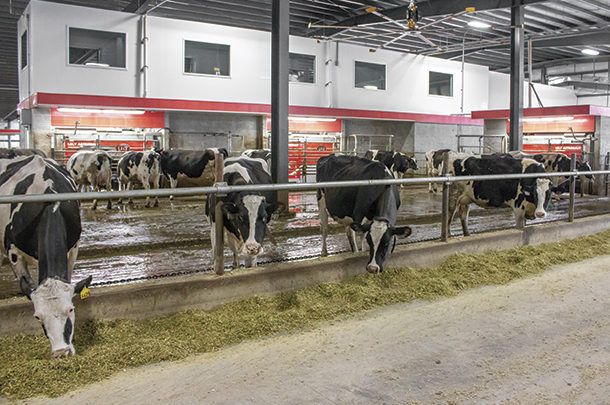Automated feeding is not necessarily a new concept. Tiestall barns utilized automated versions of concentrate feeders as far back as the 1970s and ’80s.
From there, the addition of total mixed ration (TMR) mixers made their way into the dairy arena. More recently, we’ve seen the adoption of automated feed pushing technology that allowed producers more time in their day through the reduction of labor, along with the ability to have feed pushed 24-7.
Many other innovative automated feeding approaches have also been introduced over the years. The most recent innovation, however, is the ability to automatically feed on demand. This concept provides cows a total TMR of exactly what they need when they need it, which is where we uncover the hidden dollars that may be missing in a conventional once- or twice-a-day feeding situation.
Automated feeding systems have the capabilities of doing this with the aid of a proprietary laser that measures feed height and delivers to low feedbunks based on a “feed to the need” strategy. Essentially, this involves 24-hour consumption sensing. As cows eat more, the system delivers more feed, and as cows eat less, the system delivers less. This method results in several benefits, including reduction of shrink, impeccable accuracy and consistency, overall operating cost efficiencies and, most importantly, improved rumen health.
Efficiency: Reducing feed shrink
Feed shrink occurs in a variety of ways, the most common being shrink at feedout of a storage system or shrink due to dry matter or out-of-condition feed. Reducing out-of-condition feed can lead to a reduction in feed refusal. This is one of the biggest return on investment (ROI) drivers for automated feeding. It’s not uncommon for refusals to go from the typical 3% to 5% in a traditional TMR-fed herd to 1% or less with an automated feeding system.
There are other advantages to this as well. For a conventionally fed herd, those 3% to 5% refusals often get fed to another group of animals (far-off dry cows, heifers, etc.). When we reduce refusals to less than 1%, this “extra” feed goes away, and we now have the ability to feed every group on the farm an accurate and consistent ration.
Accuracy: Feeding the diet formulated
Another large benefit of automated feeding is the impeccable accuracy and consistency. In the nutrition world, it can be said farms have three rations for each single ration formulated for the cows: the one on paper, the one unloaded at the feedbunk and the one the cow consumes. Rations can be altered by human intervention, equipment error or the cows sorting feed. When human intervention is removed from the equation, it results in impeccable accuracy and consistency. The majority of farms with automated feeding systems achieve an accuracy of 95% to 99%, meaning the ration that’s called for on paper is accurately delivered at 95% plus accuracy all day, every day.
When using automated feeding, each feeding is broken out into feeding events to ensure the ration fed at 8 a.m. is the same as the ration fed at 4 p.m. This allows every cow to have the same consistent bite of feed at every trip to the feedbunk. Aggressive cows can no longer sort all the goodies out before timid cows have a chance to get to the bunk. With automated feeding, the playing field for bunk hogs is essentially level.
Operating cost efficiencies from automated feeding come in a variety of ways and are dependent on the current situation of the farm. These efficiencies range from labor cost savings, reduced diesel fuel usage and maintenance cost savings. The result of these savings often leads to covering the cost of the automated feeding equipment within five years.
Healthy gut: Stabilizing rumen pH
Last, but certainly not least, comes the biggest hidden benefit when comparing automation to traditional feeding strategies. The rumen health benefits that come with feeding cows fresh feed when needed are astounding. It is common to see a 0.2% increase in butterfat percentages after implementing fully automated feeding. In addition, we see 5% to 15% increases in pregnancy rates. The stabilization of rumen pH that smaller, more frequent meals deliver results in a better utilization of energy and increased pregnancy rates.
So where does this advantage of rumen health come from? The whole concept of delivering fresh feed on a need to feed or consumption basis allows this to happen. When we give cows what they need when they need it, we allow them to further express their full genetic potential, delivering even higher profitability.









